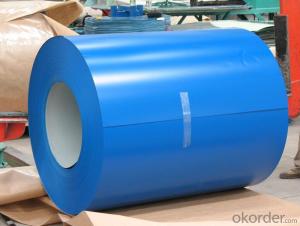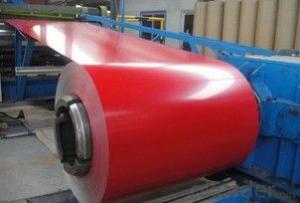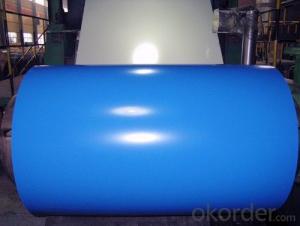PRE-PAINTED GALVANIZED STEEL COIL WITH VERY HIGH QUALITY
- Loading Port:
- Shanghai
- Payment Terms:
- TT OR LC
- Min Order Qty:
- 50 m.t.
- Supply Capability:
- 5000 m.t./month
OKorder Service Pledge
OKorder Financial Service
You Might Also Like
Painting steel is the product based on the metal sheet, of which surface is finally installed of the plastic film(PVC, PE) IN addition to being firstly covered with the coating and printed ink in. The coated layer of painting steel plate consists of chemical and filming layer, primer coated layer, pattern printed layer and surface coated layer. The top and back coating shall generally be the weatherproof paint, as well can be the application of the paint with special capabilities such as stain-resistant, self cleaning capability, high thermal resistance, antistatic capability, sterilizing capability, finger-print prevention and etc.
With GI(aluzinc) as base metal, after pretreatement(degrease and chemical treatment)and liquid dope with several layers of color, then after firing and cooling, finally the plate steel is called pre-painted galvanized (aluzinc)steel. Pre-painted galvanized steel is good capable of decoration, molding, corrosion resistance. It generally displays superior workability, durability and weather resistance.
Available specification:
PAINTING STEEL | |
BASE MATERIAL | HDGI, ALUZINC,CR |
GRADE | SGCC, DX51D,ASTMA653,EN10142,S350GD |
THICKNESS | 0.17-1.0mm |
WIDTH | 600-1250mm |
ZINC COATING | 60-200g/㎡ |
PAINT | PE,PVDF,SMP,HDP |
COILED | 508mm |
COIL WEIGHT | 3-6mt |
We can supply customers' with different specifications of the highest quality and lowest price.
Sincerely welcome to contact us for the future details if any item interest you ,and we will make every effort to assure that your requirements will be satisfied ,and we hope to establish long-term business relations with you on the basis of the equality and mutual benefit.
We are waiting for your email.
- Q:My mother is in a weilding class, and today she accidentally welded Galvanized Steel. She doesn't feel good and she wants to know what the symptoms are for Galvanized Poisoning from breathing in the Fumes. Please help, I am worried for her.
- i have a dog with a galvanized chain on her neck ''for looks'' can she get even the slightest harmful effect from it being on her 24/7?
- Q:What are the various surface finishes available for steel coils?
- There are several surface finishes available for steel coils, each with its own unique properties and applications. Some of the most commonly used surface finishes for steel coils include: 1. Hot rolled: This finish is achieved by rolling the steel at high temperatures, which creates a rough, scale-like surface. Hot rolled coils are typically used for structural applications, such as construction materials and industrial machinery. 2. Cold rolled: In contrast to hot rolled coils, cold rolled coils are rolled at room temperature, resulting in a smoother and more refined surface. Cold rolled steel is often used in automotive and appliance manufacturing due to its superior surface finish and dimensional accuracy. 3. Galvanized: Galvanizing is a process that involves coating steel with a layer of zinc to protect it from corrosion. Galvanized steel coils have a shiny, metallic appearance and provide excellent corrosion resistance, making them suitable for outdoor applications, such as roofing, fences, and gutters. 4. Electro-galvanized: Similar to galvanized steel, electro-galvanized coils are also coated with a layer of zinc. However, the coating thickness is typically thinner and achieved through an electroplating process. Electro-galvanized steel coils offer good corrosion resistance and are commonly used in the manufacturing of electrical appliances, automotive parts, and construction components. 5. Pre-painted: Pre-painted steel coils are coated with a layer of paint or polymer film on the surface. This finish provides both protection against corrosion and aesthetic appeal, allowing for a wide range of color options. Pre-painted steel coils are extensively used in the construction industry for applications like roofing, cladding, and wall panels. 6. Stainless steel: While not technically a surface finish, stainless steel coils have their own unique properties that make them suitable for various applications. Stainless steel coils are highly resistant to corrosion, heat, and chemical damage, making them ideal for industries such as food processing, medical equipment, and marine applications. These are just a few examples of the various surface finishes available for steel coils. The choice of finish depends on factors such as the intended application, desired appearance, and level of corrosion resistance required.
- Q:every time i look for steel over the internet like to build cars motorcycles ect i only get steel pipes where can i get steel sheets
- This okorder /... Most towns have a steel supply house/ business, check your yellow pages. Also check with local welding and machine shops. They can give you ideas and or their suppliers. They often have bits and pieces that you might buy, instead of ordering a full sheet of material. Wingman
- Q:How are steel coils inspected for yield strength using tensile testing?
- Steel coils are inspected for yield strength using a testing technique called tensile testing. Tensile testing involves subjecting a sample of the steel coil to controlled tension until it reaches its breaking point. This test helps determine various mechanical properties of the steel, including yield strength. To inspect steel coils for yield strength using tensile testing, a small strip of the coil is cut and prepared for testing. The strip is placed in a tensile testing machine, which consists of two grips that firmly hold the strip at opposite ends. The machine then applies a steadily increasing force to the strip, causing it to elongate until it ultimately breaks. During the test, the machine measures the force applied and the elongation of the strip. The yield strength is determined by identifying the point on the stress-strain curve where the material begins to deform plastically, or exhibit permanent deformation without any increase in load. The yield strength is typically reported as the stress required to cause a specific amount of plastic deformation, commonly 0.2% or 0.5%. This value represents the maximum stress that the steel can withstand without permanent deformation occurring. By conducting tensile testing on a sample of the steel coil, it is possible to determine its yield strength. This information is crucial for ensuring the quality and reliability of the steel coil, as it indicates the maximum stress it can withstand before permanent deformation occurs. Additionally, this testing method allows for the evaluation of other mechanical properties, such as ultimate tensile strength, elongation, and modulus of elasticity, providing a comprehensive understanding of the steel's performance characteristics.
- Q:How are steel coils inspected for width?
- To ensure compliance with the necessary specifications, various techniques are employed to inspect the width of steel coils. Among these methods, a commonly used one is the utilization of a caliper gauge, also referred to as a micrometer. This gauge makes direct contact with the coil edges to measure its width. The operator places the gauge at multiple points along the width and records the measurements. This approach guarantees precise measurements and facilitates the identification of any inconsistencies or deviations in the desired width. Another technique employed for width inspection is laser measurement. In this method, laser sensors are positioned on both sides of the coil, emitting a laser beam that scans across the width. By detecting the distance between the edges of the coil, the sensors provide accurate width measurements. This non-contact approach is highly efficient, swiftly inspecting the coil's width without causing any physical damage or requiring physical contact. Moreover, advanced systems employ computer vision technology for width inspection. This involves the use of cameras and image processing software to capture images of the coil's edges. The software then analyzes these images and calculates the width based on the detected edges. This method enables rapid inspections and can identify any irregularities in the coil's width. In conclusion, the inspection of steel coil width involves a combination of physical gauges, laser sensors, and computer vision technology. These methods ensure that the coils conform to the required width specifications and play a crucial role in maintaining quality control throughout the steel manufacturing process.
- Q:What are the dimensions of steel coils used in bridge construction?
- The dimensions of steel coils utilized in the creation of bridges can fluctuate depending on the precise requirements of the bridge undertaking. However, in general terms, the dimensions of steel coils used in bridge construction typically fall within the range of 0.5 to 1 inch in thickness and 36 to 72 inches in width. The length of the coils may also differ, but is commonly around 20 to 40 feet. These dimensions enable the production of various fundamental structural elements, such as beams, columns, and plates, which are indispensable for bridge construction. It is noteworthy that the dimensions may vary based on the specific design and engineering specifications of the bridge project, as well as the type and load capacity of the bridge being constructed.
- Q:Can steel coils be coated with vibration-damping materials?
- Yes, steel coils can be coated with vibration-damping materials.
- Q:Ok, so im gonna get my tragus pierced and i was wondering which is better, titanium or stainless steel. I hear like everyone uses stainless steel , but is titanium better?Thanks
- Ttitanium is better.
- Q:so what is stronger tempered steel Blade or carbon steel Blade? a Machete made of those i said above what will last longer,what can cut better,which will will shatter first.
- 1. all steel blades are tempered, whether they are high carbon blades or low carbon blades. 2. It depends on what kind of steel they are made from. So im going to answer this question, using the following qualifications. 440A stainless steel 440C stainless steel - high carbon. The higher the carbon level, the more brittle a blade becomes. But the higher the carbon level, will increase a steel’s wear resistance , meaning it will have a better edge retention 2. They both will work well. Pros's / Con's The 440C blades will need less sharpening, but are harder to sharpen The 4401 blades will need to be sharpened more, but are far easier to resharpen. So it basically comes down to where you will be using them and how you will be using them. If your gonna be out in the middle of the jungle and stopping for the night, then the high carbon blade would probably be better, you use it all day, resharpen it at night. If your gonna be cutting brush, tobbaco, etc on your land, then the 440A would be better, because you can take a couple of min's to resharpen it often
- Q:How are steel coils used in the production of conveyor systems?
- Steel coils are used in the production of conveyor systems as they are formed into various components such as conveyor belts, pulleys, and rollers. These components provide strength, durability, and flexibility to the conveyor system, ensuring smooth movement of materials along the conveyor and enhancing its overall performance.
1. Manufacturer Overview |
|
|---|---|
| Location | |
| Year Established | |
| Annual Output Value | |
| Main Markets | |
| Company Certifications | |
2. Manufacturer Certificates |
|
|---|---|
| a) Certification Name | |
| Range | |
| Reference | |
| Validity Period | |
3. Manufacturer Capability |
|
|---|---|
| a)Trade Capacity | |
| Nearest Port | |
| Export Percentage | |
| No.of Employees in Trade Department | |
| Language Spoken: | |
| b)Factory Information | |
| Factory Size: | |
| No. of Production Lines | |
| Contract Manufacturing | |
| Product Price Range | |
Send your message to us
PRE-PAINTED GALVANIZED STEEL COIL WITH VERY HIGH QUALITY
- Loading Port:
- Shanghai
- Payment Terms:
- TT OR LC
- Min Order Qty:
- 50 m.t.
- Supply Capability:
- 5000 m.t./month
OKorder Service Pledge
OKorder Financial Service
Similar products
New products
Hot products
Related keywords






























